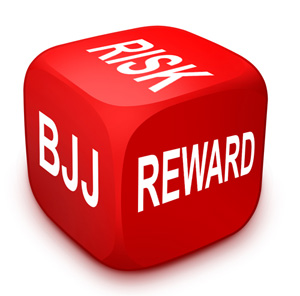BRAZILIAN JIU-JITSU LIFESTYLE AND OPINION - FIGHT STRATEGY
Take calculated risks. That is quite different from being rash. - George S Patton
In order to fight intelligently, we need to understand the relationship of risk and reward . Everything that we do in a fight has an associated risk and a potential reward. If we don’t understand how to calculate risk and reward, we will lose most of our fights. But if we chose tactics based on a good understanding of the risk reward matrix, we will usually win. Webster’s defines risk as “possibility of loss or injury”. This is especially appropriate in a Jiu-Jitsu fight. Every movement exposes us to more potential attacks by our opponent.
Webster’s defines risk as “possibility of loss or injury”. This is especially appropriate in a Jiu-Jitsu fight. Every movement exposes us to more potential attacks by our opponent.
Some movements, such as leaving an arm unprotected, can lead immediately to the loss of a match if our opponent can capitalize on our mistake. Other movements, such as being a little off balance might lead to us being swept, but not necessarily lead directly to a loss. This means that some movements are higher risk than others because the potential outcome is more negative or damaging. Understanding which movements can lead directly to defeat, and which movements are less dangerous is important to understanding the nature of risk in Jiu-Jitsu.
Although every movement that we make has associated risk, if we don’t move, we can’t win. So some movements offer the potential for reward, as well as a potential for risk. For instance if we reach out in an attempt to secure a lapel and apply across collar choke, that movement has a potential reward because if we are successful, we can finish the fight.  stay in the LRHR quad when possibleWe all know that anything can happen in a fight, but that doesn’t mean that anything is likely to happen. For instance, it’s possible that you might run out on the mat jump into a flying arm bar, and submit your opponent in 15 seconds. But let’s face it, it isn’t very likely.
stay in the LRHR quad when possibleWe all know that anything can happen in a fight, but that doesn’t mean that anything is likely to happen. For instance, it’s possible that you might run out on the mat jump into a flying arm bar, and submit your opponent in 15 seconds. But let’s face it, it isn’t very likely.
Over time we develop an intuitive understanding of what is a likely outcome in a particular situation, and what is not very likely. We start to understand how things might unfold before they actually do. This ability to predict outcomes is critical and we can use this understanding to help us make decisions that keep us in the right quadrant of the risk reward matrix.
Without a good understanding of risk and reward, we may move just for the sake of movement. This is always dangerous. We should only move when we have a clear idea of why we are moving and what the potential outcomes are.
Sometimes we don’t know what to do in a particular situation and so we might try something without a clear understanding of the potential outcome. This is part of the learning process and can be quite helpful as long as we are mindful about what we are doing and what we are trying to learn. But mindlessly moving without thinking about where we are going will always lead to creating many opportunities for our opponents and very little for us.
We also need to understand how a specific situation influences the risk reward matrix.
Facing an opponent of equal skill dictates a balanced approach. Fighting against an opponent who is more skilled than you favors higher risk tactics because the longer the match continues the less likely you are to win. Fighting an opponent with less skill than you requires patience and using low risk tactics because eventually they will leave an opening that you can exploit - it’s almost inevitable.
Time also plays a role. If it's late in the match and you are losing it's time to attempt some high-risk maneuvers that have the potential for high reward. If you’re winning a match with only a little time left in the fight use low risk tactics that don’t offer any openings to your opponent.
So with a proper understanding of risk and reward, and good situational awareness we can put ourselves in the best possible position when selecting tactics to use during a fight.
- Bill Thomas





